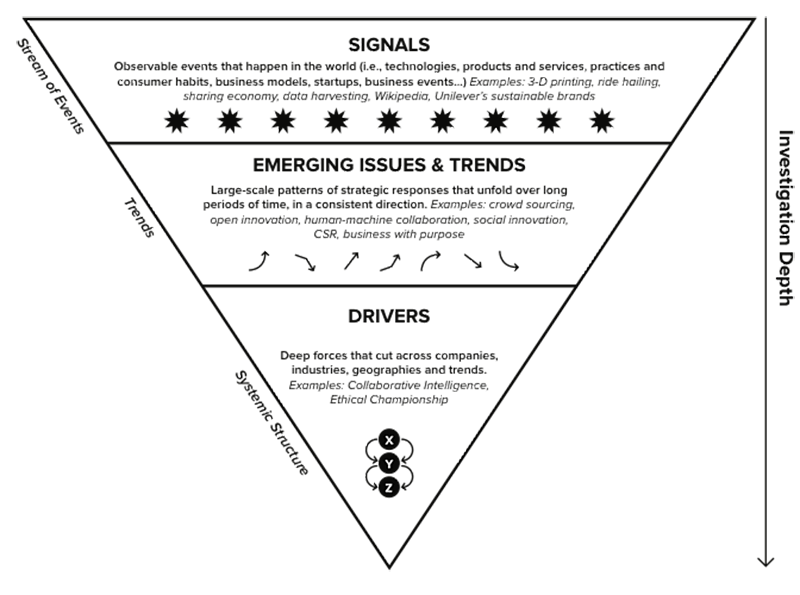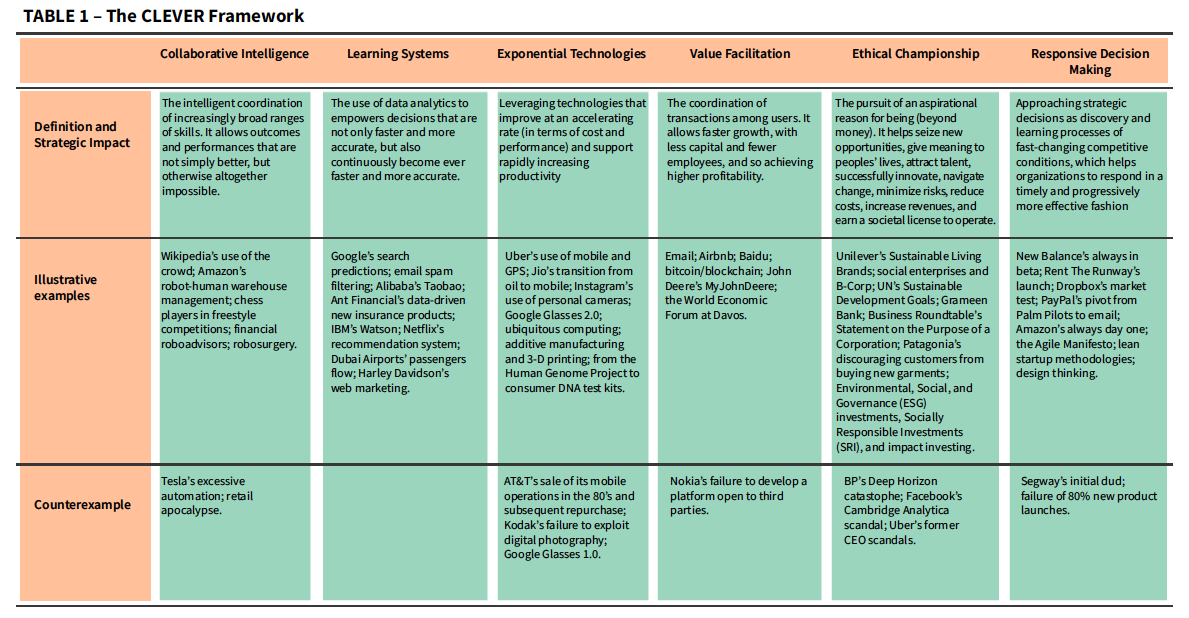Every day business news cover dozens of new products, technologies, consumer behaviours, and business models that could be critical to the future of business and should not be ignored. Yet, the sheer volume of this apparently critical information means that most business leaders have no choice but to ignore it. Doing so may be without consequences in the short run, but over time it compounds leaving their businesses lagging behind and sometimes committed to strategic decisions that are no longer fit. In these times of accelerating change, catching up becomes increasingly difficult and may condemn organizations to rapid obsolescence.
The post-pandemic era is one of ultra rapid change, characterized by increasing volatility, uncertainty, complexity and ambiguity (VUCA). In the past 50 years, the average lifespan of a business model has dropped from 15 years to less than five and the average length of time a company stays on the Fortune 500 has shortened from sixty years to just eighteen. The COVID-19 pandemic has all but accelerated these trends. Therefore organizations must continuously update their strategic decisions.
A VUCA world is a shift in kind rather than degree. Tried and tested approaches cannot be simply updated, they should be altogether replaced.[1] Even as strategic decisions become increasingly short lived, the rules of strategy are being constantly rewritten. As exponential technologies like artificial intelligence (AI), biotechnologies, blockchain, augmented and virtual reality, 3D printing and robotic agents become a reality, they empower new consumer behaviors and business models, which are precipitating a new economic era that is rapidly transforming the way organizations succeed.
As organizations experience the rapid pace of technological transformation of the post-pandemic era and as their go-to principles of strategy are being rewritten, they look for new solutions. In rapidly changing environments, where business models have a short lifespan, companies need to continuously look to the future. This explains a growing interest in foresight among both scholars and practitioners. In a previous article,[2] my coauthors and I discussed how companies can cultivate foresight for the long run. In this article, I illustrate the drivers of strategy for the near future, which can be used across companies and industries to craft a future-ready strategy.[3]
To navigate the new economic landscape companies need to identify and interpret not individual changes, but the deeper forces that trigger change. What are the old principles of strategy that are no longer adequate? And what are the new, dominant forces that determine strategic success?
Changing Strategic Principles
Strategy scholars have espoused two key schools: the positioning and the resource-based. The positioning school, championed by Michael Porter, instructs companies to position themselves in an attractive industry (using the Five Forces), establish a competitive focus through differentiation or low cost, and operate a coherent value chain. According to the resource-based school, companies should cultivate unique resources and capabilities to develop a durable competitive advantage to best their competitors.
While in academic debates the resource approach is now dominant, in managerial practice the two approaches complement one another.[4] Yet, as the post-pandemic era shapes different competitive landscapes, both positioning-based and resource-based principles are increasingly insufficient to guide strategic decisions and their tried-and-tested applications need to be reconsidered.
Industry borders are becoming blurred
Successful companies such as Alibaba and Amazon operate dozens of business models across multiple industries at the same time: business-to-business, business-to-consumer, and consumer-to-consumer; domestic and international; they sell other companies’ products as well as their own; they are active in retail, logistics, cloud computing, warehouse management solutions, payments, insurance, travel, corporate services…. The pillars of the positioning school have seemingly become less critical to success. Prof. Porter himself acknowledged that, as smart connected products shift the basis of competition from single products to broad systems of value creation of which a firm is one of many elements, the boundaries of industries expand (Porter and Heppelmann, 2014).[5] As a result “competitive advantage no longer comes from low cost or product differentiation,”[6] but from perfecting business models that can deliver ever evolving, customer centric, value propositions.
Furthermore, business models that leverage data into customized value creation are increasingly industry neutral. What market is Uber in: a) chauffeurs and taxis, b) food delivery, c) post and parcels, d) all of the above? The students and executives in my training immediately answer with a resounding: “D!” But they pause when I ask them: “What industry is ‘all of the above?’”
Competitive advantage is becoming transient
In a VUCA competitive landscape, competitive advantages are no longer durable. They are, at best, transient.[7] For example, industrial scale in the form of factories and logistic and distribution channels once offered a durable competitive advantage, but is now increasingly becoming available for rent (Taneja and Maney, 2018).[8] Product development can be crowdsourced, manufacturing outsourced to the likes of Foxconn, retail via Amazon, and logistics handled by FedEx or UPS. None of this requires large capital expenditures and can be accessed even by the latest startups. In fact, capitalism is becoming decoupled from physical and financial capital. When resources become widely available, they no longer offer a durable competitive advantage.
Ecosystems, not companies are the new unit of competitive analysis
Unlike companies managing a linear supply chain, ecosystems are complex and integrated networks of separate entities co-creating value. Companies in an ecosystem operate as nodes in a network. Even as Apple and Google compete over mobile operating systems, Google pays Apple $12 billion per year to remain the default search engine on Apple’s browser Safari,[9] while Apple lets its users access Google’s apps and rents Google’s cloud for its iCloud service.[10] Apple and Google surely compete, but they also need each other in order to thrive. So, the relationships among nodes are not strictly transactional, but complex and multifaceted.
Data is the new oil
Data is a new sort of fuel that powers digital business models in the 4IR. Just like oil, data must be extracted, processed, valued, and traded. Indeed, there are new businesses models built solely around data collection and exploitation, operated by new digital giants. Yet, data also differs greatly from oil. For one, it isn’t fungible, which means that each data point is unique, and so difficult to price. In addition, while oil is finite and scarce, the supply of data is constrained only by our capacity to capture and store it. By combining data with other data, you create additional data that may be even more valuable. The more you use it, the more of it you have, and the more valuable it potentially becomes. To understand the importance of this last point, imagine a barrel of oil that, when you set it aflame, doesn’t burn. Instead, new oil gushes out of it. This way data changes the economics of value creation.
These dramatic changes in the principles of strategy are pushing companies to approach strategic decisions differently, with a more deliberate focus on the future.
Uncovering Deep Strategic Drivers with Strategic Foresight
As mentioned in the opening, there are many cases of technologies, business models, and other similar signals of change business leaders should not ignore. While case studies are powerful signals of successful strategic innovations, they may represent exceptions rather than rules. Further analysis is required to uncover the trends underlying these cases. Trends are the aggregated patterns of change that describe many technologies, business models, and other similar signals. Yet, even trends may be transient or declining. Therefore a further step is necessary to identify drivers: the forces that cause changes. Figure 1 shows what these progressive levels of investigation mean.
Figure 1:

Foresight is an exercise rooted in the past to uncover the dominant forces that determine strategic success in the future, so that companies can respond now.
The result is a framework of six strategic drivers, the handful of underlying forces that determine the viability of strategic decisions during the 4IR.
CLEVER
The first three elements of the framework represent the “hard” features—the technological components of the framework—while the second three capture decision-making and managerial styles. CLEVER is an acronym for:
Collaborative Intelligence
The organizations that best cope with the uncertainty of ultra-rapid change, do so by intelligently coordinating a broad range of skills. For example, they combine the skills of humans and machines and coordinate tasks that cater to their strengths, as Amazon does in its warehouses where Kiva robots collaborate with human workers. Other companies tap into scattered crowds—intelligently coordinating many human beings of diverse skillsets with different experiences, expertise, and origins, as Wikipedia does to create and validate its vast repository of human knowledge. Some companies engage in open innovation—using knowledge and resources that are internal as well as external (e.g., consumer feedback, competitors, universities), as Lego does when it invites its customers to suggest ideas for new products. The intelligent coordination of a broader range of skills allows outcomes that are not simply better, but otherwise altogether impossible.
Learning Systems
Today’s organizations have access to unprecedented amounts of data. This information can provide unique insights, but it’s impossible for humans to parse such enormous datasets on their own. Organizations can use machine learning algorithms (or AI) to process these vast stores of data into a meaningful analysis. For example, Netflix tracks the behavior of its viewers and analyzes it to extract information. With such information, Netflix’s algorithms make automatic decisions such as recommending other content that each viewer is likely to enjoy.[11] They have become so accurate that 80% of the content streamed on the platform comes from recommendations. Netflix also leverages that information to plan and produce new content its viewers want to watch. The world-famous series “House of Cards” was developed on the basis of viewers’ ratings. Unlike its competitors, Netflix didn’t need a pilot episode for the series, because the theme, the lead actor, and the director had already been validated by millions of users. The success rates of traditional TV shows are 30%-40%. Netflix original shows’ are 80%. Nowadays most applications only use the simplest form of learning and automation. Nonetheless, Learning Systems allow companies to make decisions that are not only faster and more accurate, but also continuously become even faster and more accurate.
Exponential Technologies
In the early 1960s Gordon Moore, one of the founders of microprocessor manufacturer Intel, observed that computing power doubled every eighteen months, while halving in size and cost. Other digital technologies are improving at a similar accelerating pace. By some estimates, if digital technologies continue improving at this rate, we will experience the equivalent of last century’s worth of innovation in the next twenty years. Taken individually, Exponential Technologies can transform every aspect of the economy: consumer behaviors, as Uber and Careem do by leveraging the diffusion of GPS; to value creation, as Apis Cor did by 3-D printing a building for Dubai Municipality; education, as Coursera does by leveraging a widespread fast internet; agriculture, like John Deere does equipping its machinery with sensors connected to the Internet of Things; healthcare, as 23andMe does with its inexpensive genetic testing kits…. As these technologies converge—that is, they integrate into and reinforce each other—they support ultra-rapid increases in productivity.
Value Facilitation
In a market transaction, value is created by making an exchange with someone who values what you give them more than you do, in return for something that you value more than they do. However, the largest companies in the world no longer engage in transactions that create value this way. They create platforms that make it easier for other people to make these exchanges. For example, Airbnb does not own or rent properties. It ‘merely’ facilitates the exchange between tourists and landlords. Value Facilitation can be arranged almost entirely virtually and it depends on users to create value for each other. Therefore it allows faster growth, with less capital and fewer employees, and so achieving higher profitability.
Ethical Championship
Traditional businesses create value for shareholders, disregarding the costs for other stakeholders. For this reason trust is business is declining. The majority of respondents to the Edelman Trust Barometer 2020 believe that “capitalism as it exists today does more harm than good in the world.”[12] Many companies embrace a purpose, what EY and Harvard Business Review define “an aspirational reason for being which inspires and provides a call to action for an organization…and provides benefit to society.”[13] For example, Unilever launched a range of Sustainable Living Brands, with the goal of making the world a better place, while being profitable. Businesses that pursue such dual goals (positive social impact and financial sustainability) find it easier to attract talent, drive successful innovation, and implement transformational change. This is reflected in the financial bottom line, as companies that operate with a purpose beyond making money outperformed the S&P 500 by a factor of 14 between 1998 and 2013.[14] Ethical Championship helps companies seize new opportunities, give meaning to peoples’ lives, attract talent, successfully innovate, navigate change, minimize risks, reduce costs, increase revenues, and earn a societal license to operate by making the world a better place.
Responsive Decision Making
A VUCA world is a shift in kind rather than degree. Tried and tested approaches cannot be simply updated, they should be altogether replaced. It is self-evident that organizations are not—and cannot be—experienced at making new decisions in fast changing contexts. Therefore business leaders need to instill a culture of learning to overcome knowledge gaps between the old and the new. Entrepreneurial startups free from legacy structures are especially effective at this type of learning, for example by following the ‘lean startup’ methodology and applying another popular approach to learning is called design thinking. Larger corporations are rapidly adopting these approaches. For example, GE’s Energy Storage division developed its offering for the Durathon battery using a lean approach. Responsive decision making is a strategic driver that encompasses all these approaches to strategic decision making as discovery and learning processes of fast-changing competitive conditions, to which organizations must respond effectively and timely.

Enacting CLEVER
Business leaders know that the world is increasingly VUCA. Yet, most are still surprised by events that compromise their organization’s long-term profitability. It may seem that the world changes randomly and that we cannot usefully foresee emerging states. While predictions for an uncertain future are problematic, organizations need some degree of planning to guide strategic decisions. Foresight offers critical support and invaluable insights in the three to five-year timeframe considered for most strategic decisions.
For effective foresight, understanding drivers is paramount. Trends continue only if the underlying conditions that triggered them – the drivers – are still active. Drivers allow broad general directions to be investigated to inform strategy formulation. That’s how CLEVER helps decision makers take strategic action now and in the future.
A strength of the framework is that its drivers apply across companies, industries, and geographies. For example, a Portuguese fintech with international operations used two drivers – Exponential technologies and Value facilitation – to assess the promise of banking-as-a-service. The corporate venture of a family business in Italy refocused its strategy around a three-sided platform that leverages the power of the crowd to create and distribute custom-designed cards and board games (Collaborative intelligence and Value facilitation), embraced a more agile decision-making approach (Responsive decision making) and transitioned to carbon-neutral operations (Ethical championship). Finally, the UAE University launched a multi-stakeholder initiative to educate the country in preparation for the 4IR that is openly inspired by the CLEVER framework.[15]
Business leaders can use the framework to better understand the diverse forces that determine the viability of strategic decisions during this new economic era, to find inspiration to take strategic action, and to ensure their organizations embark on a future-ready strategic path.
Phase 1. Information gathering: a systematic collection of relevant signals and trends, informed by academic knowledge and consulting company reports.
Phase 2. Diagnosis is a three-step exercise: In-Depth Analysis of the potential and likely trajectory of the main trends; Clustering of the most relevant trends; Identification of the drivers connected with the most important trend clusters in the context of analysis.
These two phases are more technical in nature and therefore can result in fairly objective replicable findings. Based on these phases, a third becomes possible. Phase 3. Strategy formulation to respond to the dominant trends, incorporating the main drivers. The third phase must reflect the subjective attitudes of key decision-maker. Therefore, this research does not recommend what individual business leaders should do, but only explains how they should approach decisions. CLEVER can be used across companies and industries.
Acknowledgement
Financial support by the Hult Research ‘Creating Disruption’ grant no. 481953141 is gratefully acknowledged.
About the Author

Dr. Alessandro Lanteri is Professor of Entrepreneurship at Hult in Dubai and London, teaches for Saïd Business School University of Oxford, and writes for Harvard Business Review Arabia. An expert educator, he helps executives and students navigate turbulent environments and seize the opportunities of the Fourth Industrial Revolution. He works with multinationals, governments and startups across five continents. His research has appeared on Harvard Business Review and MIT Technology Review outlets, World Economic Forum Agenda and Forbes. His latest book “CLEVER. The Six Strategic Drivers for the Fourth Industrial Revolution” became a no.1 Amazon bestseller. Homepage: www.alelanteri.com
References
- [1] Schoemaker, P., Heaton, S., & Teece, D. (2018). Innovation, dynamic capabilities, and leadership. California Management Review, 61(1), 15-42.
- [2] Fergnani, A., Hines, A., Lanteri, A. & Esposito, M. (2020). Corporate foresight in an ever-turbulent era. European Business Review, 25th September 2020.
- [3] Lanteri, A. (2019). CLEVER: The six strategic drivers for the Fourth Industrial Revolution. Lioncrest.
- [4] Martin, R. (2015). Strategy is about both resources and positioning. Harvard Business Review. URL: https://hbr.org/2015/04/strategy-is-about-both-resources-and-positioning
- [5] Porter, M. & Heppelmann, J. (2014). How smart, connected products are transforming competition. Harvard Business Review, 92(11), 64–88.
- [6] Gupta, S. (2018). Driving digital strategy: A guide to reimagining your business. Harvard Business Press. Page 21
- [7] Porter, M. & Heppelmann, J. (2014). How smart, connected products are transforming competition. Harvard Business Review, 92(11), 64–88.
- [8] Porter, M. & Heppelmann, J. (2014). How smart, connected products are transforming competition. Harvard Business Review, 92(11), 64–88.
- [9] Porter, M. & Heppelmann, J. (2014). How smart, connected products are transforming competition. Harvard Business Review, 92(11), 64–88.
- [10] Porter, M. & Heppelmann, J. (2014). How smart, connected products are transforming competition. Harvard Business Review, 92(11), 64–88.
- [11] Lanteri, A. (2020). Three Questions to Use Learning Systems and Get Ahead During Troubled Times. Harvard Business Review (Arabic), URL: https://hbrarabic.com/?p=213365.
- [12] Edelman (2020). Trust Barometer 2020. URL: https://www.edelman.com/trustbarometer.
- [13] EY and Harvard Business Press (2015). The Business Case for Purpose. Cambridge MA: Harvard Business School Publishing.
- [14] Sisodia, R., Sheth, J., & Wolfe, D. (2014). Firms of endearment: How world class companies profit from passion and purpose (2nd ed.). New Jersey: Pearson FT Press.
- [15] Cappuccio, M. & Al Najjar, F. (2020). What is the district 4.0 project being built in the UAE? Harvard Business Review (Arabic). URL: https://hbrarabic.com/جامعة-الإمارات-تدفع-الدولة-للأمام.



































